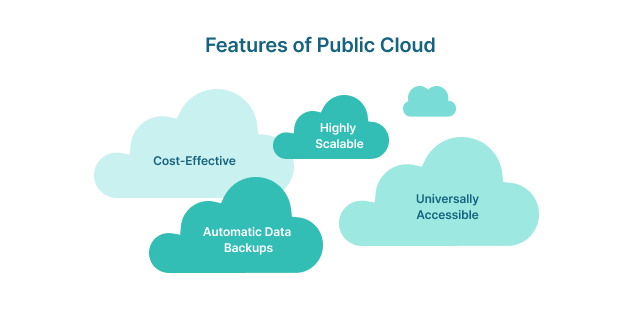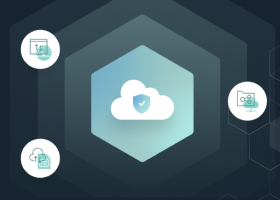What Is Public Cloud?
Public cloud is a cloud computing service that offers organizations and individuals compute resources, development platforms, application hosting, virtual machines, networking, and storage services. With public cloud, services are available on a subscription or a usage basis, and users can quickly access additional resources on demand as needed.

Public cloud is available through cloud service providers, such as Amazon Web Services (AWS), Microsoft Azure, and Google Cloud Platform (GCP). It provides users with scalability, connectivity, and resource sharing capabilities without the investment in equipment and labor.
A few considerations when selecting a public cloud service provider are:
- Uptime performance
What is offered, and what is the service provider’s past performance? - Service offerings
What is the range of services, and do they align with workload and operational requirements? - Integration capabilities
Can the services be integrated with existing technology? - Pricing
Do the pricing models fit? Are you able to estimate costs accurately? - IT Security
Does the cloud service provider have security systems that adhere to internal and compliance requirements? - Backup and recovery
Are systems in place for automated backup? What are the procedures for recovery? How quickly can systems be brought back online?

Why Consider Public Cloud?
There are many reasons to consider using a public cloud. Below are a few of the commonly cited benefits of a public cloud.
- Agility
Public cloud services allow organizations to quickly respond to changing requirements, either increasing capacity, scaling back, or adding new services. - Business continuity
The backup and recovery systems provided by public cloud providers facilitate continuity of service with minimal disruption in the event of unexpected downtime. - Cost efficiency
Public cloud services offer a range of payment options that allow users to choose what works best for their needs. Public cloud pricing is generally based on usage or offered as a subscription with a right to use for a period of time. - Fast and easy setup
A public cloud can be deployed and configured remotely by an IT team over the internet without expert support. - Geo-diversity
Because public cloud services are based in many locations and accessible via the internet, organizations can have a presence in data centers in multiple locations. - Low maintenance
With public clouds, cloud service providers take care of systems maintenance (e.g., servers, networks, applications, security). This allows organizations to eliminate costs related to housing, maintaining, and supporting those systems. In addition, public cloud users benefit from the cloud service providers’ economies of scale. - Uptime assurance
Contracts with public cloud providers include a commitment to an agreed-upon level of uptime. In addition, public cloud services use multiple servers so that they can roll to another system in the event of a failure.
How Public Cloud Works
Public cloud services use a multi-tenant environment that can serve thousands of organizations rather than the single-tenant environment typically used for private cloud deployments. Despite the fact that multiple users share the same resources (e.g., hardware, storage, networks) with other tenants in the cloud, each tenant’s data is isolated from others’ data.
Three public cloud service models are:
- SaaS
Software-as-a-service providers sell access to software solutions that are hosted in a public cloud. With SaaS, users can access software from anywhere with any internet-connected device. This enables users to access the software from internet-connected devices. - PaaS
With platform-as-a-service, service providers host applications and tools in a public cloud. PaaS is used to build and support high-performance environments that are delivered over the internet.
Commonly used for product development, PaaS gives access to powerful systems without the expense of building and maintaining those environments yourself.
- IaaS
In the case of infrastructure-as-a-service, entire data centers are moved to public clouds, with everything being offered via a server-side delivery model. This gives access to production servers, storage, and virtual compute resources from any device with an internet connection.
Features commonly available in a public cloud environment are the following:
- Availability to ensure consistent access to data and systems
- Cloud monitoring tools to collect data and gain visibility into usage trends
- Connectivity to provide ready access to users wherever they are
- Pay-per-use pricing allows organizations to pay only for the resources and storage space that they use
- Pooling space and resources and making them provisionally available to multiple clients
- Provisioning resources on-demand, per each organization’s specifications
- Redundancy to provide failover capabilities in the event of an unexpected outage or disaster
- Security systems to provide best-of-breed protection mechanisms—physical and digital
Public Cloud vs. Private Cloud vs. Hybrid Cloud
Public cloud, private cloud, and hybrid cloud each have their strengths and weaknesses, and they offer different approaches and features. Below is an outline of the differences between public cloud and private cloud deployments. Hybrid cloud deployments offer the option to pick and choose the aspects of each that best suit an organization’s specialized requirements.
| Public Cloud | Private Cloud |
| Multi-tenant with a shared infrastructure | Single-tenant with a dedicated infrastructure |
| Accessible via the internet | Accessible via a private network |
| Security functions may not align with internal standards | Security functions adhere to internal requirements |
| Maximum flexibility and redundancy | Limited flexibility and redundancy |
| No investment in hardware and networking | Initial investment in hardware and networking |
| Costs remain constant relative to usage | Costs depreciate over time and are not directly tied to usage |
| Security managed by a service provider | Security managed by internal IT resources |
| Capacity on demand | Capacity has to be resourced and deployed |
| Service providers handle all updates and patches | Updates and patch management are handled internally |
| Open to customers | Open only to the organization that is hosting it |
Public Cloud—A Valuable Addition to IT Quivers
Organizations of all sizes across most verticals find value in public cloud services. One of the biggest arguments against public cloud use is the perceived vulnerabilities from a security perspective. Ironically, experts consider public clouds to be more secure than on-premises deployments, because of their ability to invest in and support the best security solutions available for digital and physical assets.
Public cloud deployments are also popular for their impact on people. Organizations need fewer people to manage IT, while making it possible to support more users with more services cost-effectively.
While exclusive use of public cloud deployments is not for every organization, it has become a must-have for most IT portfolios. Organizations that have resisted public cloud services should take time to reconsider. In most cases, public cloud offerings prove to be a valuable part of an organizations’ IT quiver.
Egnyte has experts ready to answer your questions. For more than a decade, Egnyte has helped more than 16,000 customers with millions of customers worldwide.
Last Updated: 11th July, 2022



